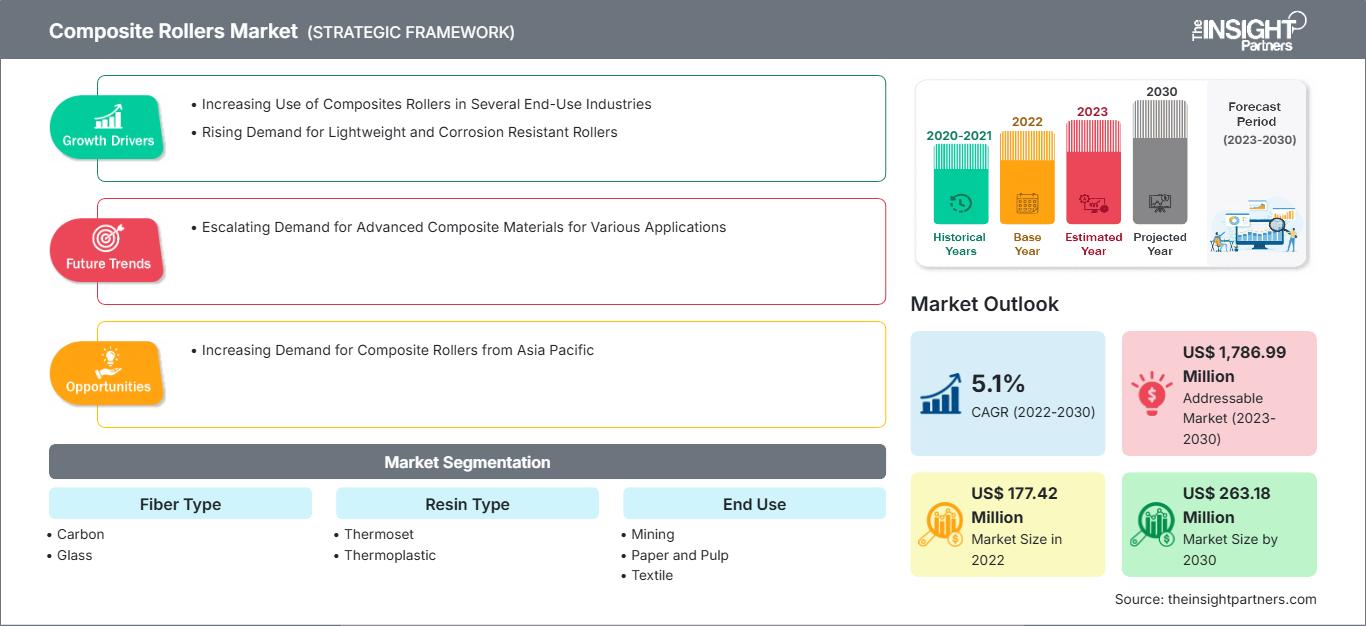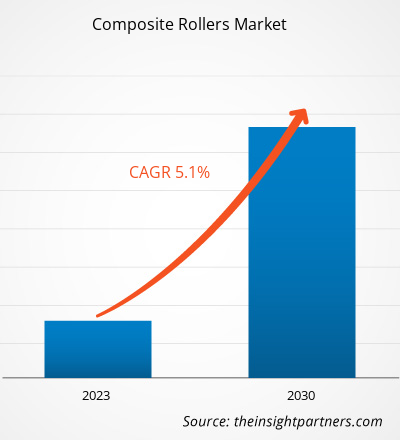[Forschungsbericht] Der Markt für Verbundrollen soll von 177,42 Millionen US-Dollar im Jahr 2022 auf 263,18 Millionen US-Dollar im Jahr 2030 wachsen; von 2022 bis 2030 wird eine durchschnittliche jährliche Wachstumsrate (CAGR) von 5,1 % erwartet.
Markteinblicke und Analystenmeinung:
Der globale Markt für Verbundrollen erlebt einen deutlichen Nachfrageschub aufgrund des steigenden Bedarfs an leichten und langlebigen Materialien in verschiedenen Branchen. Verbundrollen werden aus modernen Materialien wie Kohlefaser, Glasfaser und Kevlarfaser hergestellt, die ein hohes Festigkeits-Gewichts-Verhältnis sowie Korrosions- und Abriebfestigkeit bieten. Sie werden häufig in Fördersystemen, Druckmaschinen, Laminiermaschinen und anderen industriellen Anwendungen eingesetzt, um effiziente Materialhandhabungs- und Transportsysteme zu gewährleisten. Der zunehmende Fokus auf Nachhaltigkeit und Energieeffizienz dürfte die Nachfrage nach Verbundwerkstoffwalzen weltweit weiter ankurbeln.
Wachstumstreiber und Herausforderungen:
Verbundwerkstoffwalzen werden in verschiedenen Branchen eingesetzt, beispielsweise in der Druck-, Textil-, Bergbau- sowie der Papier- und Zellstoffindustrie. Diese Walzentypen werden unter Verwendung verschiedener Technologien aus Rohstoffen wie Kohlenstoff- und Glasfasern, Harzen und Beschichtungen hergestellt. Die ständige Weiterentwicklung, vor allem bei Industriemaschinen, geht mit einfacher Handhabung, geringerem Energieverbrauch und geringem Gewicht einher. Ein solches Szenario eröffnet neue Perspektiven für die Verwendung von Verbundwerkstoffen in vielen Industriezweigen. Verbundwerkstoffwalzen finden in bestimmten Bereichen des Bergbaus Anwendung, beispielsweise in kleinen und großen Maschinen. Daher wird erwartet, dass die zunehmenden Bergbau- und Explorationsaktivitäten die Nachfrage nach diesen Walzen ankurbeln und damit das Marktwachstum für Verbundwerkstoffwalzen fördern. Der zunehmende Einsatz von Verbundwerkstoffwalzen in der Zellstoff- und Papierindustrie stimuliert das globale Marktwachstum für Verbundwerkstoffwalzen. Die Verbundwerkstoffwalzen werden in der Zellstoff- und Papierindustrie häufig verwendet. Papierindustrie, da sie hervorragende Festigkeit, reduzierte Vibrationen und Geräusche, geringe Trägheit und niedrigen Stromverbrauch bieten. In der Papier- und Zellstoffindustrie werden Verbundwalzen für Anwendungen wie Papierleitwalzen, Leitwalzen für Siebe oder Filze, Walzen für die Trockenpartie, Schüttelbrustwalzen und Kalanderleitwalzen eingesetzt. Der Faktor, der das Wachstum des globalen Marktes für Verbundwalzen behindert, ist jedoch die wachsende Umweltbedenken hinsichtlich des Recyclings von Kohlenstoff- und Glasfaserverbundwerkstoffen. Die zunehmende Verwendung von Kohlenstoff- und Glasfaserverbundprodukten hat das Bewusstsein für deren Abfallentsorgung geschärft. Die weit verbreitete Verwendung von Verbundwerkstoffen führte zu einem massiven Anstieg des Müllaufkommens. Das wachsende Interesse daran, diese Verbundabfälle kostengünstig und ohne negative Auswirkungen auf die Umwelt zu recyceln, nimmt zu.
Passen Sie diesen Bericht Ihren Anforderungen an
Sie erhalten kostenlos Anpassungen an jedem Bericht, einschließlich Teilen dieses Berichts oder einer Analyse auf Länderebene, eines Excel-Datenpakets sowie tolle Angebote und Rabatte für Start-ups und Universitäten.
Markt für Verbundwalzen: Strategische Einblicke

-
Holen Sie sich die wichtigsten Markttrends aus diesem Bericht.Dieses KOSTENLOSE Beispiel umfasst Datenanalysen, die von Markttrends bis hin zu Schätzungen und Prognosen reichen.
Berichtssegmentierung und -umfang:
Der „Globale Markt für Verbundwalzen“ ist nach Fasertyp, Harztyp, Endverwendung und Geografie segmentiert. Basierend auf dem Fasertyp ist der Markt für Verbundwalzen in Kohlenstoff, Glas und Sonstiges segmentiert. Das Kohlenstoffsegment ist weiter unterteilt in PAN-basiert und Pech-basiert. Der Markt für Verbundwalzen ist basierend auf dem Harztyp in Duroplast und Thermoplast segmentiert. Das Duroplastsegment ist weiter unterteilt in Epoxid, Polyurethan und Sonstiges. Das Thermoplastsegment ist weiter unterteilt in Polyethylen, Polypropylen, Polyvinylchlorid und Sonstiges. Der Markt für Verbundwalzen ist basierend auf der Endverwendung in Bergbau, Papier und Zellstoff, Textil, Film und Folie, Druck und Sonstiges segmentiert. Der Markt für Verbundwalzen ist geografisch in Nordamerika (USA, Kanada und Mexiko), Europa (Deutschland, Frankreich, Italien, Großbritannien, Russland und das übrige Europa), Asien-Pazifik (Australien, China, Japan, Indien, Südkorea und der übrige Asien-Pazifik-Raum), Naher Osten und Afrika (Südafrika, Saudi-Arabien, die Vereinigten Arabischen Emirate und der übrige Nahe Osten und Afrika) sowie Süd- und Mittelamerika (Brasilien, Argentinien und der übrige Süd- und Mittelamerika) unterteilt.
Segmentanalyse:
Basierend auf dem Fasertyp ist der Markt für Verbundwalzen in Kohlenstoff, Glas und andere segmentiert. Das Kohlenstoffsegment hatte einen bedeutenden Anteil am Markt für Verbundwalzen und wird im Prognosezeitraum voraussichtlich ein beträchtliches Wachstum verzeichnen. Kohlenstofffasern sind lange, dünne Materialstränge, die aus Kohlenstoffatomen bestehen. Diese Fasern bieten eine hohe Zugfestigkeit bei gleichzeitig hoher Temperaturbeständigkeit und Haltbarkeit. Kohlenstofffasern besitzen eine höhere Steifigkeit und Festigkeit, ausgezeichnete Korrosionsbeständigkeit und eine längere Lebensdauer als andere Materialien wie Aluminium und Stahl. Daher finden diese Fasern ein breiteres Anwendungsspektrum in verschiedenen Endverbrauchsbranchen. Diese Fasern sind starr und chemisch inert, was ihre Kompression und Dehnung erschwert. Sie werden in verschiedenen Endverbrauchsbranchen wie Bergbau, Textil, Zellstoff und Papier, Luft- und Raumfahrt und Verteidigung, Automobilindustrie und Bauwesen eingesetzt.
Regionale Analyse:
Geografisch ist der Markt für Verbundwalzen in fünf Hauptregionen unterteilt: Nordamerika, Europa, Asien-Pazifik, Süd- und Mittelamerika sowie Naher Osten und Afrika. Der globale Markt für Verbundwalzen wurde vom asiatisch-pazifischen Raum dominiert, der im Jahr 2022 über 80 Millionen US-Dollar ausmachte. Nordamerika ist ein zweitgrößter Marktteilnehmer und wird im Jahr 2028 voraussichtlich mehr als 20 % des globalen Marktanteils für Verbundwalzen ausmachen. Für Europa wird von 2022 bis 2030 ein signifikantes Wachstum von über 4 % erwartet. Der europäische Markt für Verbundwalzen ist in Deutschland, Frankreich, Italien, Großbritannien, Russland und das übrige Europa segmentiert. Länder wie Großbritannien, Deutschland und Russland erleben ein signifikantes Wachstum bei der Implementierung technologisch fortschrittlicher Lösungen. Bergbau, Textil sowie Zellstoff und Papier gehören zu den weiteren florierenden Branchen in der Region und stützen somit das Wachstum des Marktes für Verbundwalzen. Im Bereich der Bergbauaktivitäten nimmt Russland eine bedeutende Position in der Welt ein und in der Bergbauindustrie werden diese Verbundwalzen immer beliebter. Auch die Textilindustrie trägt stark zur steigenden Nachfrage nach Verbundwalzen in Europa bei.
Branchenentwicklungen und zukünftige Chancen:
Nachfolgend sind verschiedene Initiativen der wichtigsten Akteure auf dem Markt für Verbundwalzen aufgeführt:
- Im Jahr 2023 stellte Rulmeca die neue Rulmeca-Verbundwalze vor. Das neu eingeführte Produkt ist eine nichtmetallische Rolle für Schüttgutförderer.
- Im Jahr 2021 brachte Pronexos eine neue Reihe verschleißfester Verbundbeschichtungen, Tonex, auf den Markt, die Kunden neue kostengünstige Optionen für Rollenanwendungen mit kohlenstofffaserverstärktem Kunststoff (CFK) bieten.
- Im Jahr 2021 produzierte Pronexos sehr lange Kohlefaserrollen für Theater auf Kreuzfahrtschiffen.
- Im Jahr 2023 ging EPSILON Composite, ein Hersteller von Kohlefaserrollen, eine Partnerschaft mit Packone Solutions ein, um seine Produkte in Indien, Sri Lanka, Nepal und Bangladesch zu bewerben und zu vertreiben.
- Im Jahr 2022 übernahm Double E Company LLC Daven Manufacturing LLC. Mit dieser Übernahme plant Double E Company LLC, seine Reichweite auf die Bodenproduktion auszuweiten und seine Mission fortzusetzen, Produktivitäts- und Sicherheitslösungen zu liefern, die betriebliche Herausforderungen in der gesamten verarbeitenden Industrie lösen.
Markt für Verbundwalzen
Die Analysten von The Insight Partners haben die regionalen Trends und Faktoren, die den Markt für Verbundwalzen im Prognosezeitraum beeinflussen, ausführlich erläutert. In diesem Abschnitt werden auch die Marktsegmente und die geografische Lage von Verbundwalzen in Nordamerika, Europa, im asiatisch-pazifischen Raum, im Nahen Osten und Afrika sowie in Süd- und Mittelamerika erörtert.Umfang des Marktberichts zu Verbundwalzen
| Berichtsattribut | Einzelheiten |
|---|---|
| Marktgröße in 2022 | US$ 177.42 Million |
| Marktgröße nach 2030 | US$ 263.18 Million |
| Globale CAGR (2022 - 2030) | 5.1% |
| Historische Daten | 2020-2021 |
| Prognosezeitraum | 2023-2030 |
| Abgedeckte Segmente |
By Fasertyp
|
| Abgedeckte Regionen und Länder |
Nordamerika
|
| Marktführer und wichtige Unternehmensprofile |
|
Dichte der Marktteilnehmer für Verbundwalzen: Verständnis ihrer Auswirkungen auf die Geschäftsdynamik
Der Markt für Verbundwalzen wächst rasant. Die steigende Nachfrage der Endverbraucher ist auf Faktoren wie veränderte Verbraucherpräferenzen, technologische Fortschritte und ein stärkeres Bewusstsein für die Produktvorteile zurückzuführen. Mit der steigenden Nachfrage erweitern Unternehmen ihr Angebot, entwickeln Innovationen, um den Bedürfnissen der Verbraucher gerecht zu werden, und nutzen neue Trends, was das Marktwachstum weiter ankurbelt.

- Holen Sie sich die Markt für Verbundwalzen Übersicht der wichtigsten Akteure
Auswirkungen von COVID-19:
Die COVID-19-Pandemie betraf fast alle Branchen in verschiedenen Ländern. Lockdowns, Reisebeschränkungen und Geschäftsschließungen in Nordamerika, Europa, im asiatisch-pazifischen Raum (APAC), Süd- und Mittelamerika (SAM) sowie im Nahen Osten und Afrika (MEA) behinderten das Wachstum mehrerer Branchen, darunter der Chemie- und Werkstoffindustrie. Die Schließung von Produktionsstätten von Verbundwalzenherstellern störte globale Lieferketten, Fertigungsaktivitäten und Lieferpläne. Verschiedene Unternehmen erlebten 2020 Verzögerungen bei Produktlieferungen und einen Einbruch der Verkäufe ihrer Produkte.
Mehrere Branchen kommen wieder auf Kurs, da sich die Lieferengpässe, die diese Branchen betreffen, allmählich auflösen. Darüber hinaus steigt die Nachfrage nach Verbundwalzen aus der Film- und Die Folien-, Druck-, Textil- und Bergbauindustrie fördert das Wachstum des Marktes für Verbundwalzen erheblich.
Wettbewerbslandschaft und Schlüsselunternehmen:
Dongguan Precision Converting Transmission Co Ltd, Pronexos BV, Composite Conveyor Equipment Co, Carbon Light Pvt Ltd, PROK Pty Ltd, ADENTE Advanced Engineering Technologies, Lorbrand (Pty) Ltd, Double E Co LLC, HAHL GmbH und Rossini SpA gehören zu den wenigen Akteuren auf dem globalen Markt für Verbundwalzen. Die Akteure auf dem globalen Markt für Verbundwalzen konzentrieren sich auf die Bereitstellung qualitativ hochwertiger Produkte, um die Kundennachfrage zu erfüllen.
- Historische Analyse (2 Jahre), Basisjahr, Prognose (7 Jahre) mit CAGR
- PEST- und SWOT-Analyse
- Marktgröße Wert/Volumen – Global, Regional, Land
- Branchen- und Wettbewerbslandschaft
- Excel-Datensatz
Aktuelle Berichte
Erfahrungsberichte
Grund zum Kauf
- Fundierte Entscheidungsfindung
- Marktdynamik verstehen
- Wettbewerbsanalyse
- Kundeneinblicke
- Marktprognosen
- Risikominimierung
- Strategische Planung
- Investitionsbegründung
- Identifizierung neuer Märkte
- Verbesserung von Marketingstrategien
- Steigerung der Betriebseffizienz
- Anpassung an regulatorische Trends






















 Kostenlose Probe anfordern für - Markt für Verbundwalzen
Kostenlose Probe anfordern für - Markt für Verbundwalzen